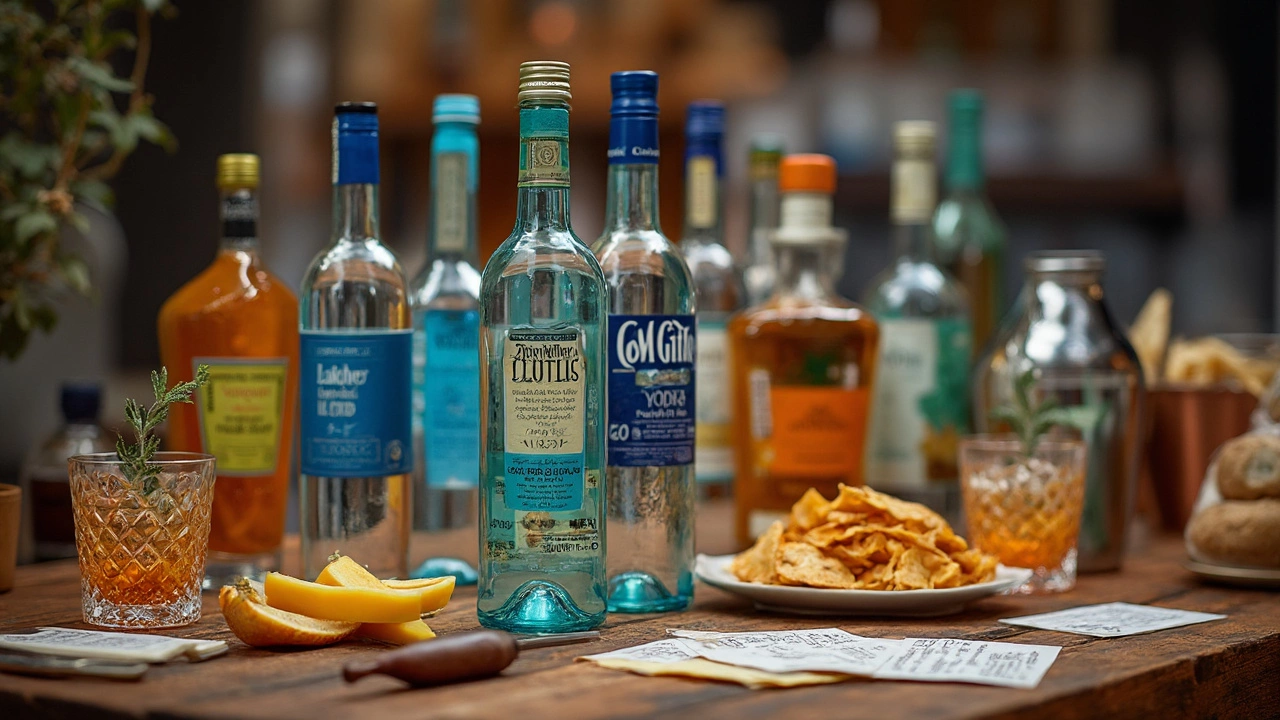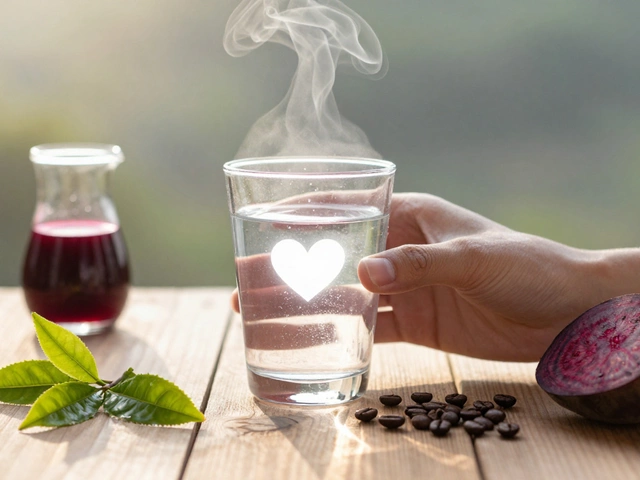Picture this—you’re staring at a wall of vodka bottles at your local shop, and each label promises something different. Some say 'ultra-premium', others boast about how many times they're distilled, and a few claim to be so smooth you'll barely notice they're there. Yet, let’s be real—most vodkas, especially budget picks, taste like someone dropped nail polish remover in your glass. If you’ve ever reluctantly powered through a vodka shot that punched you in the throat, you’ll get why the hunt for the easiest tasting vodka matters so much. It isn’t just about flavor. It’s about a genuinely enjoyable, almost effortless sip that doesn’t leave you gasping or hunting for a lime wedge. So, what makes a vodka go down easy? And which brands have actually nailed it?
What Makes Vodka Taste 'Easy'?
When someone says a vodka is ‘easy tasting’, they usually mean it’s smooth—no harsh burn, no rubbing alcohol bite, and ideally, no weird chemical aftertaste. But what does 'smooth' even mean for vodka? Chemistry actually has the answer. Vodka is water and ethanol, but it also contains trace impurities: these can include esters, aldehydes, and even tiny fusel oils. Premium brands work overtime (or pay for smart distilling) to strip those out, which is why a true “neutral” vodka can taste almost like water, with just the tiniest sweetness or creamy texture.
Some distillers even use different base ingredients (wheat, rye, potato, even grapes) to nudge the final flavor. For most people, wheat-based vodkas are the easiest and softest—think Belvedere or Grey Goose—while rye or potato vodkas might feel a touch creamier or earthier. An easier-tasting vodka is almost always distilled several times and filtered—sometimes through charcoal, quartz, or, in the case of elitist brands, even diamonds. Would you notice the difference? Absolutely, if you’re sipping neat or mixing into a classic martini.
It’s not just the ingredients and process, either. Temperature matters—a lot. Cold vodka, almost frozen, will taste smoother as the chill numbs your palate and masks alcohol’s sharp edge. If you want the easiest first time, pop your bottle in the freezer for a couple of hours. Also, check the ABV. Most standard vodkas sit at 40% alcohol. Some go higher, which can add to the burn, so stick to the regulars if you want to play it safe.
Fun fact: The Beverage Testing Institute in Chicago actually gives out awards each year for the smoothest, cleanest vodkas. In taste tests, they serve samples at room temperature (not straight from the freezer!) to judge how easy and pure each one is. A neutral aftertaste and minimal heat: that’s the holy grail for easy sippers.
| Base Ingredient | Flavor Profile | Smoothness |
|---|---|---|
| Wheat | Soft, clean, slightly sweet | Very smooth |
| Rye | Spicy, creamy | Smooth |
| Potato | Earthy, full-bodied | Creamy, less "neutral" |
| Grape | Fruity, soft | Ultra-smooth |
Top Vodka Brands for a Smooth Sip
There’s a sea of vodka brands on the shelves, all claiming to be the easiest, smoothest, or most premium you’ll ever taste. But only a select few consistently win over both judges and regular folks who'd rather not wince with every sip. If you want the short list, here it is:
- Belvedere: Made from Polish rye and quadruple-distilled, this one’s famous for its almost buttery texture. One reviewer at the San Francisco World Spirits Competition called it “remarkably gentle, with a soft vanilla finish.”
- Grey Goose: French winter wheat gives it that signature soft, almost slightly sweet character. Their unique distillation method—‘single distillation in a column still’—actually preserves some nuanced, wheaty flavors, which makes it smooth in cocktails or neat.
- Tito’s Handmade Vodka: Coming out of Austin, Texas, Tito’s is corn-based, which makes it gluten-free (if that matters for you). People swear by its easy, round flavor—a little peppery, but with close to zero after-burn. Plus, it’s wallet-friendly. My mates always reach for this at barbecues or when mixing up espresso martinis at home.
- Chopin: A Polish potato vodka, Chopin is creamy, full-bodied, and definitely less neutral, but still super easy on the palate for those who find wheat vodkas a bit thin.
- Ciroc: Distilled from French grapes, this one stands out from the usual crowd. Slightly fruity, almost icy-clean, and incredibly easy for newbies. Perfect if you’d like a hint of character in your martini without facing the booze dragon head-on.
According to vodka expert Tony Abou-Ganim, “Smoothness is all about balance—too much filtration and you lose all character; not enough, and it feels like punishment.” You’ll see this play out when you line up these bottles and taste them side by side. The best way? Pour each into a small glass, chill them, and sip slowly. Notice which makes you want a second mouthful, versus which sends you reaching for a chaser.
Looking local, in Sydney, Archie Rose vodka has racked up awards for its ultra-clean, full-bodied style, and it’s the first bottle I grab for a neat pour on a summer afternoon. If you want something adventurous, hunt down some small-batch vodkas like Hartshorn Sheep Whey Vodka from Tasmania—this one’s a conversation starter and surprisingly smooth, thanks to the unique whey base.

How to Judge Vodka Smoothness at Home
So, you want a vodka that doesn’t make your face scrunch up—how do you test that yourself? Here’s how you can be your own taste expert, without fancy lab equipment or a super-trained palate.
- Chill Your Vodka: Place your bottle in the freezer (not the fridge, not with ice) for at least two hours. Cold dampens harsh ethanol notes and helps with that “easy” sensation.
- Use Standard Glassware: A simple shot glass or small tumbler works better than plastic. Glass won’t add weird flavors, and you can swirl and sniff properly.
- Sip, Don’t Shoot: Take a small mouthful and hold it in your mouth for a second. Easy-tasting vodkas feel almost creamy or silky on the tongue, while harsh ones will hit with a noticeable “burn” or chemical note late in the palate.
- Notice the Finish: Swallow slowly. If you find yourself reaching for a chaser or grimacing, it’s not the easy-going vodka you wanted. Smooth vodkas fade out gently, leaving almost no sharp aftertaste.
- Try Side-by-Side: Line up a few brands. Most people can tell the difference after just two or three sips—some will taste almost flavorless (a good sign for many), others will hit with heat, bitterness, or ethanol. That’s your clue.
Try this test on a few highly-rated bottles: Belvedere, Grey Goose, Tito’s, Ciroc, and Smirnoff (as a value benchmark). I’ve done this with friends—the “blind tasting” style makes it fun, and you’ll hear plenty of honest reactions. Want to go further? You could jot down your scores for 'nose' (smell), 'mouthfeel' (how it feels as you sip), and 'finish' (the aftertaste and warmth).
At home, it’s not about award panels or rare vodkas—it’s about what feels pleasant and drinkable with zero effort, even on its own. If you’re using it for cocktails, the smoothest vodka will make everything else shine without sneaking in harsh flavors. Try it next in a simple vodka soda and see how 'easy' the drink feels through to the last sip.
Tips to Enjoy Vodka Without the Burn
If you’re not loving vodka straight—don’t blame yourself. Even with the smoothest brands, vodka’s not naturally as forgiving as, say, rum or bourbon. But there are tricks to make the ride smoother, especially for those who cringe at the tiniest hint of 'boozy' flavor.
- Mix Smart: Classic mixers like soda water, cranberry juice, or even coconut water can mellow out vodka’s sharp edges. If you’re opting for flavor, try a splash of ginger beer—it covers awkward notes and tastes summery.
- Infuse at Home: Toss sliced cucumber, a few strawberries, or even fresh jalapeño into a bottle. Let it sit for a day in the fridge. You just ‘made’ a boutique, easy-drinking vodka that’s custom built for you.
- Chill Everything: Not just the vodka, but your glasses, mixers, even your garnishes. Cold makes all the difference, especially if you’re new to sipping spirits.
- Pair with Food: A small snack—crackers, smoked salmon, pickles—can enhance flavors and cut through the alcohol. It’s why vodka is paired with caviar or blinis across Russia and Poland. But trust me, it works just as well with salty chips on a Friday night.
- Sip Slowly: The slower you go, the less overwhelming the heat. Plus, you’ll start to notice subtle flavors (like sweet, peppery, or grassy notes) you’d otherwise miss in a quick shot.
Small differences in how you serve and sip make a massive impact on taste. A study from the American Chemical Society found that chilling vodka to -18°C reduced the alcohol 'bite' perception by more than 40%. Tiny tweaks, huge results. If you're gathering mates for backyard cocktails, an ice bucket and some fresh citrus is all it takes to trick even the budget vodkas into tasting easier.
And if you’re ever at a Sydney bar, ask the bartender for their 'cleanest' pour. Local pros usually know the smoothest stuff on hand—sometimes it's an import, other times a craft batch distilled a few suburbs away. No shame in asking. After all, no one enjoys cocktails that taste like paint thinner.

Vodka Myths: What Really Matters in Flavor
Lots of people still believe more distillations automatically equal a better or easier vodka. It's not always that simple. The 'five times distilled' on a label can just mean clever marketing. In reality, after removing most impurities by three or four distillations, the differences become almost microscopic.
Filtration, too, matters—but only up to a point. Some brands like Crystal Head tout their 'diamond filtration', but independent taste panels rarely pick out these ultra-premium vodkas as smoother than well-made, simpler bottles. A 2023 test by Difford’s Guide found that the top-ranked vodkas for 'ease of sipping' were priced between $35-$60, not $200.
"True smoothness comes from careful distillation and clean water, not just fancy labels. Trust your tastebuds." – Alice Lascelles, Drinks Reviewer at The Financial Times
Ever wondered if additives matter? European and Aussie rules let vodka makers add tiny traces of sugar or glycerin for mouthfeel. That creamy, subtle sweetness in some bottles is no accident. It’s legal, and it helps beginner drinkers find vodka a whole lot easier to drink. Don’t let purity hype fool you—some of the biggest international brands use this trick.
One last thing: vodka fresh-bottled tastes better than stuff that’s sat open for months (air exposure and sunlight dull the flavors). So if your bottle tastes weird or sharp, you might just need a new one. Vodka isn’t wine—it won’t age gracefully in a dusty cupboard above the stove.
In the hunt for the easiest tasting vodka, what you’re really after is a blend of smoothness, subtle sweetness, and almost zero harshness. Now, you’ve got the road map and a bunch of tried-and-tested picks to start exploring. No more dreading that first sip, or covering the glass with citrus just to get through a martini. Cheers to smooth—even if your kids, like Lennox and Evanna, are just watching your DIY taste-test with that classic, 'Dad, are you really just drinking water?' look. Promise, it’s science.


